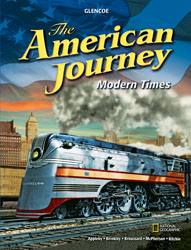
The American Journey Modern Times © 2009Chapter 7: The Progressive EraChapter OverviewsSection 1: The Progressive Movement Many Americans in the late 1800s felt that government and big business were taking advantage of the American people. Known as Progressives, they fought to break the power of corrupt politicians and business people. Congress passed acts to break the spoils system, control monopolies, regulate the railroad, and lower tariffs. Reformers included those who wanted to solve social problems through socialism and progressivism. Muckraking reporters and other writers exposed corruption in business and government. Other progressives pushed for laws that gave voters more power in choosing candidates. Section 2: Women and Progressives In the late 1800s, many middle-class women were becoming less focused on the home. These educated “new women” were active in social work and cultural clubs, and often led urban reform movements. Despite opposition from both men and women, suffragists organized, protested and finally won women’s right to vote in 1920. Women also worked to pass laws to improve lives throughout society by organizing workers and banning alcohol. Section 3: Progressive Presidents When Theodore Roosevelt became president in 1901, he brought progressive ideas to the White House. His Square Deal introduced a new era of government regulation. Unlike previous presidents, Roosevelt used arbitration to resolve labor disputes. He strongly believed in and supported wilderness conservation. Elected in 1908, President William Howard Taft supported many progressive reforms, including safety standards for mines and railroads. However, Taft disappointed Roosevelt and other progressives when he failed to lower tariffs and changed some conservation policies. The progressives then broke with the Republicans and formed the Progressive Party. Because of this split, Democrat Woodrow Wilson won the1912 presidential election. Section 4: Excluded from Reform During the 1800s, the majority of Americans were white and Protestant, and believed the country should remain that way. Members of religious and ethnic religious minority groups, including Catholics, Jews, and Asian immigrants faced discrimination. The majority of the country’s African Americans lived in the South in communities separated from whites, and were often victims of Ku Klux Klan violence. Meanwhile, some progressive reforms, though intended to improve society, furthered discrimination against particular groups. African American leaders such as Booker T. Washington, W.E.B. Du Bois, and Ida B. Wells sought to increase educational opportunities and obtain equal rights for African Americans. Native Americans and Mexican Americans also fought to end discrimination. |  |















